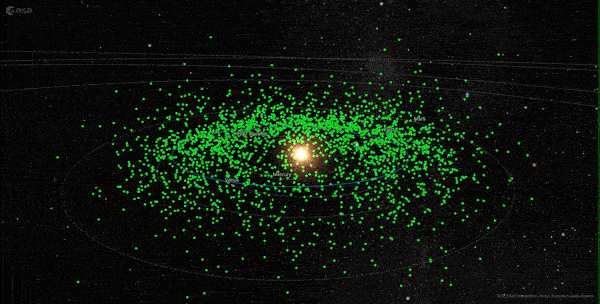ESA asteroid toolkit: how to guide
In brief
ESA’s Near-Earth Object Coordination Centre (NEOCC) – home to Europe’s team of experts keeping an eye on potentially risky asteroids – has developed four freely available tools to better understand the small bodies scattered through our Solar System, and the risk they pose Earth.
In-depth
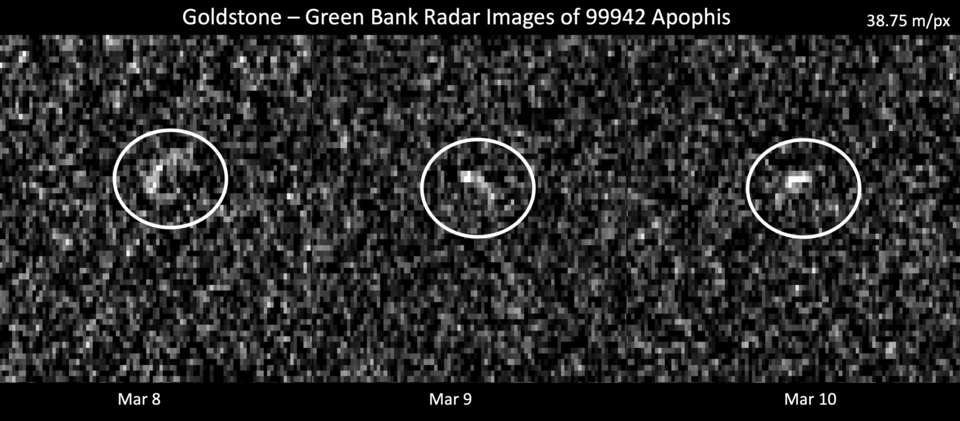
With the new near-Earth object (NEO) Toolkit you can visualise any asteroid’s orbit, including those making a close approach of Earth; get impressive illustrations of different groups and families of asteroids as well as plan upcoming observations and chart asteroids paths across the sky from any location in the world.
Freely available via neo.ssa.esa.int/neo-toolkit, the tools are for professional and amateur astronomers alike, along with journalists, media and schools looking for accurate visuals and anyone with an interest in asteroids.
The NEO Toolkit includes the Observation Planning Tool, Sky Chart Display Tool, Orbit Visualisation Tool and the Flyby Visualisation Tool.
Using the infamous Apophis asteroid as a case study, find out below how to get started.
Orbit Visualisation Tool
The Orbit Visualisation Tool allows you to visualise individual asteroid orbits or see groups of asteroids in orbit based on their asteroid group, family, spectral class or observation priority. To get started, click on the arrow next to “Select objects” at the upper left of the screen to make your selection.
NEO Groups
All near-Earth objects fall into one of four groups: Atira, Aten, Apollo or Amor. This depends on their orbital period – the time it takes for one full rotation around the Sun – and whether their orbit crosses Earth’s own.
Apophis, our case study, is for example an Aten asteroid as it has an orbital period shorter than Earth’s but still crosses Earth’s own path around the Sun. After its close flyby of Earth in 2029 however, Apophis’s orbit will be shifted enough by our planet’s gravity that it will fall into a different category: becoming an Apollo asteroid.
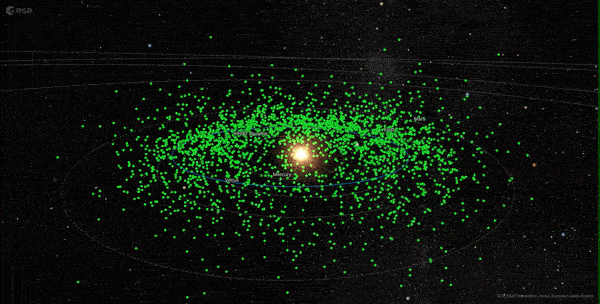
Asteroid families
Asteroids are grouped into a family if they share orbital characteristics, such as the shape of their orbit (eccentricity) or how ‘high’ they rise from the orbital plane (orbital inclination). However, families of asteroids are also thought to have originated from the same original object. As fragments from past asteroid collisions, they are the leftovers of a much larger asteroid, a failed planet.
Spectral class
An asteroid is classified with a specific spectral class depending on the sunlight it reflects; its particular emission spectrum, colour and sometimes its albedo (brightness). From this, astronomers get insights into the composition of an asteroid’s surface. Apophis, for example, is classified as an S-class asteroid, because of its stony composition.
Observational priority
Asteroids on ESA’s Asteroid Risk List – the ever-changing list of asteroids that have a ‘non-zero’ chance of impact in the next hundred years – can also be selected. That’s right, more than 95% of known near-Earth asteroids have no chance of impact in a decade. The rest are being closely monitored, until experts have enough data to say for certain they will not strike.
Flyby Visualisation Tool
With the Flyby Visualisation Tool, any asteroid that will come within three lunar distances of Earth can be easily visualised as it makes its close approach. Flybys past, present and future can be conjured up, showing how an asteroid’s path bends and warps as it gets near our planet and past it.
Search for any asteroid flyby over a given time period, or if you have a specific asteroid in mind simply click “Edit my list of objects” and add it to your list.
Apophis will make a close Earth approach on 13 April 2029. By choosing a start date of 1 Jan 2029 and an end date of 31 Dec 2029, all flybys currently known within three lunar distances from Earth for that year appear, including (99942) Apophis. Alternatively, add the asteroid to your selected objects to filter just for Apophis flybys.
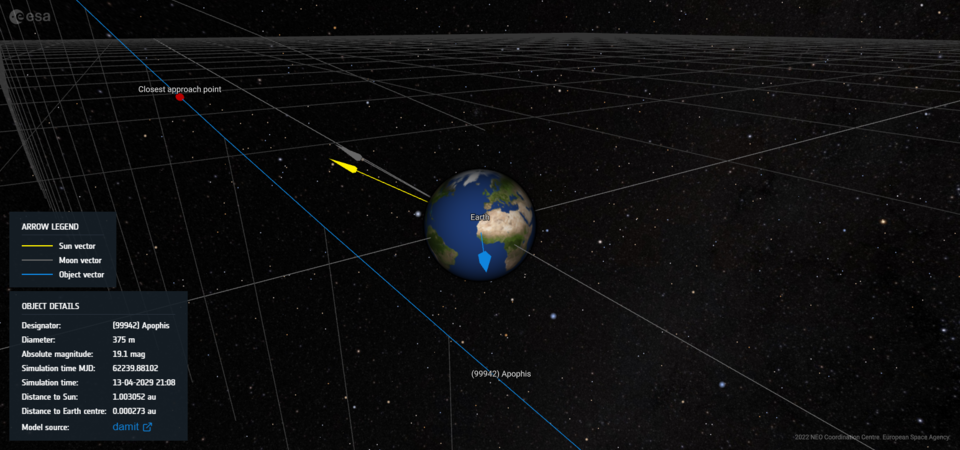
Apophis’ path five days before and five days after closest approach can be played out using the media buttons under the image. The moment of close approach is coloured red at the centre of the time bar, and various options are available to alter the view, from altering the speed to zooming in or out on Earth or on the asteroid, inverting the colours and adding or removing various details on screen.
Share your search results using the share button on the top left. Session data will be stored for 30 days. You can take a screenshot or movie of what you’re looking at using the “Export” button on the right.
Observation Planning Tool
The Observation Planning Tool can be used to check if and when an asteroid will be visible from any location on Earth, and when you’ll have the very best conditions for upcoming asteroid observations.
The tool can be used for any date(s), but it provides precalculated physical data and ‘ephemerides’ (a table showing the trajectory of an object over time) for observations within 30 days from the present date. Further into the future than this the planning tool still works but will take a bit longer to finish the calculation of all ephemerides.
This tool considers multiple variables over the timeframe selected that affect an asteroid’s visibility, including the relative position of the Sun, Moon and Galaxy, the sky’s movement, the density of the stars and the visibility and limitations of the telescope being used.
Under the “Setup” tab, add the date range in which you are interested, the location of the “observatory” (you!) and add the asteroid or asteroids of interest. Click “Go to Filtering”.
Under the Filtering tab you’ll find the list of asteroids selected and the visibility data in a graph format. Select your ‘time step’, i.e. the time interval between observations you’d like to check, and click “Calculate ephemerides”.
To find out if and when Apophis will be visible over the month of January 2023, the following observation data was provided by the tool.
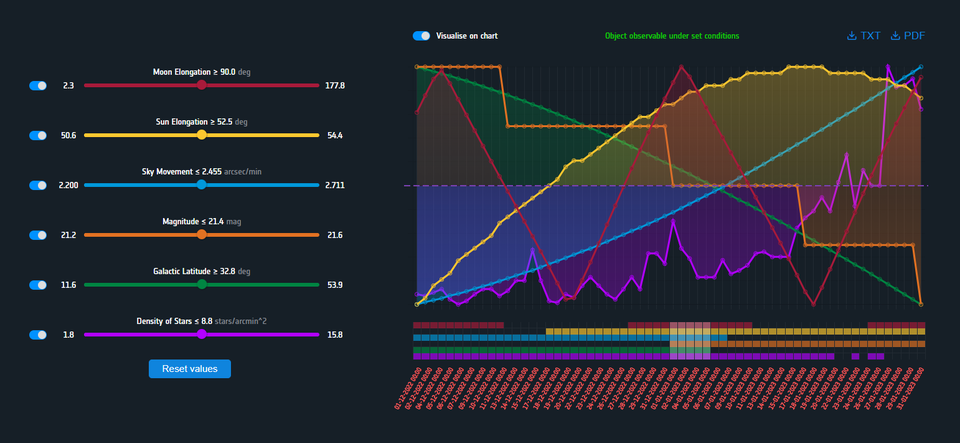
At the time this guide was prepared, asteroid Apophis was just over 200 million km from Earth. The Observation Planning Tool shows that Apophis will be visible for five days in the month of January 2023, seen from Darmstadt, Germany, under certain conditions shown in the bars on the left-hand side.
Use the sliders to filter for the viewing conditions acceptable for the capabilities of your telescope.
Moon elongation describes the Moon’s angular distance from the asteroid in question, as seen from the Earth (the vertex of the angle).
Sun elongation similarly describes the angular distance between the Sun and the asteroid to be observed.
Sky movement describes the speed of near-Earth objects in the sky with respect to the background stars.
Magnitude describes the evolution of the apparent magnitude of the selected asteroid in the sky during the period selected.
Galactic Latitude is measured in degrees north or south of the Galaxy's fundamental plane of symmetry. This plane is defined by the galactic equator, the great circle in the sky best fitting the plane of the Milky Way, as determined by a combination of optical and radio measurements.
The density of stars changes as asteroids move through the sky and their background constantly changes. This measure refers to the number of stars per square arcminute in the area surrounding the selected asteroid.
Sky Chart Display Tool
Finally, with the Sky Chart Display tool, you can see where near-Earth asteroids will appear in the night sky from any location on Earth. You can visualise a particular day or extend an asteroid’s path through time to see how it will move across the sky.
Select the timeframe in which you will be observing and your location, and then add the asteroid(s) of interest. Either chose ‘Topocentric’ for a view from a point on Earth’s surface or ‘Geocentric’ for a view from Earth’s centre.
Click on “Go to Visualisation” to create your asteroid sky chart. Note: For dates far in the future, it will take some time for the sky chart tool to load.
This sky chart for Apophis was created for the month of January 2023, daily markers every two days and the observer located in Darmstadt, Germany.
Use the ‘Display settings’ on the top-right to add or remove features such as coordinate grids and telescope parameters or to alter look of the asteroid trail. Add or remove constellations and deep sky objects by clicking on “Background objects” and decrease or increase the Field of View using the sliding bar on the bottom right.
Click “Print” on the right to save what you see.
Synodic Orbit Visualisation Tool
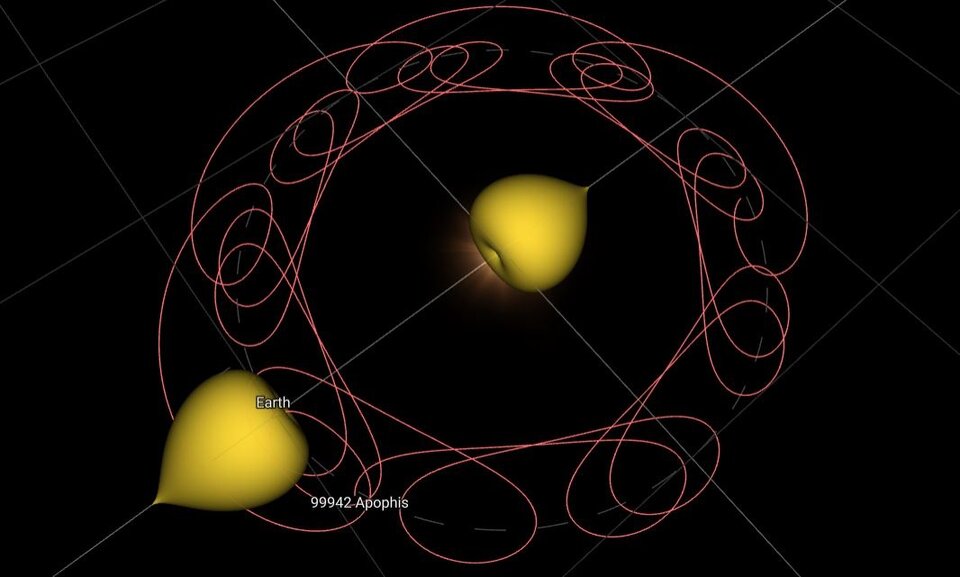
The Synodic Orbit Visualisation Tool offers a different perspective.
To get started with the tool, select one or more objects on the left. You can set the visual magnitude of the telescope and then select a time period at the bottom of the screen. The object will then be shown in 3D with a choice between a Keplerian and a perturbed orbit. The perturbed orbit takes into account the gravitational effects of bodies in the Solar System.
You can see the detection polar displayed with a toggle on the right, becoming visible as a yellow, balloon-like shape. If the chosen object’s trajectory at any point in time crosses into this region, it is observable with the chosen telescope’s limiting magnitude at that point in time.
Another possible overlay is the solar elongation cone, which is the part of the field of vision that is blocked because it is too close to the Sun. Here, the Sun is so bright that it is impossible to observe the much dimmer reflections of the NEOs.
Further toggles and settings allow you to adapt the visualisations further. The object orbit range will show the inner and outer boundaries of the range of the object from the Sun. Different bodies can be displayed either larger or proportional to their true size.
There are also charts available that plot the asteroid’s distance to Earth, its phase angle and the resulting visual magnitude of the object throughout the chosen time period.
The visualisations can also be exported as an image or a video file.
More information about the Synodic Orbit Visualisation Tool can be found in this article and in the tutorial video.
We hope you enjoy the NEO Toolkit!


